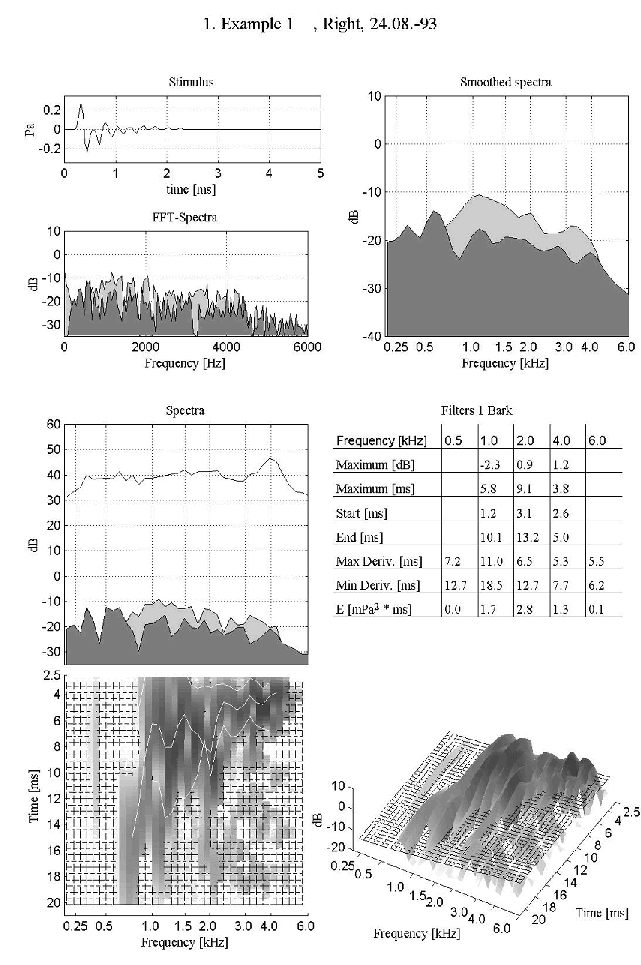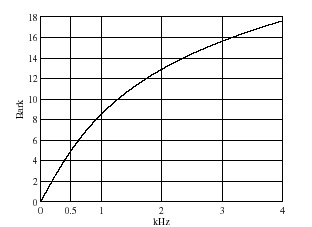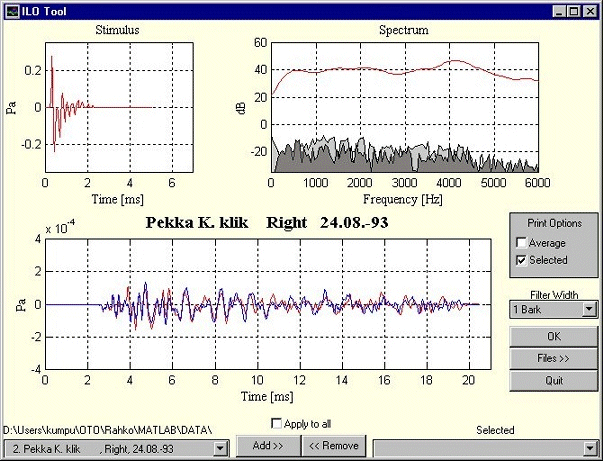A MATLAB tool for analysis of Transient Otoacoustic Emission signals
Pekka Kumpulainen
Measurement and Information Technology,
Tampere University of Technology, P.O. BOX 692, FIN-33101Tampere, Finland,
kumpu@ee.tut.fi
Phone Int + 358 3 365 2458, Fax Int + 358 3 365 2171
co-authors
Heimo Ihalainen and Tapani Rahko
Tampere University of Technology and Tampere University Hospital
Tampere, Finland
Note from the Editor: If you are using a 800 x 600 display you will have to use the arrow keys in order to view the whole text of this presentation. The reason for this "inconvenience" is the presence of a 2D picture which becomes incoherent at smaller dimensions.
1 ) INTRODUCTION
In addition to the audiometric test, the measurement of the transient evoked otoacoustic emissions (TEOAE) can be used in examination of hearing. The results of the audiometric test depend completely on the patient's subjective observation. Measurement of the (TEOAE) is believed to provide objective information on the condition of the cochlea. Statistically there is a correlation between the spectrum of the TEOAE and the audiometric threshold but in individual cases it is difficult to determine the threshold. In addition to the power spectrum, the behaviour of different frequencies of the TEOAE in time domain gives essential information. A MATLAB tool was developed to perform the time-frequency analysis. The development was done in co-operation with the Tampere University Hospital, where the tool is used daily. It can be used to analyse groups of measurements and the results can be saved for further statistical analysis. It is also possible to print out graphical presentations of the results of each measurement.
2 ) TRANSIENT EVOKED OTOACOUSTIC EMISSION
Otoacoustic emission is a result of active movements of the hair cells in the cochlea when sensing sound. TEOAE is a measurable sound emission after a transient stimulus. This phenomenon was first discovered by Kemp in 1978 [1] and a clinically acceptable measuring equipment was developed by Bray [2]. Now the TEOAE's are accepted as a part of audiological practice.
3 ) TIME-FREQUENCY ANALYSIS
A band-pass filter bank was selected to perform the time-frequency analysis [3]. Bandwidth of each filter is 1 Bark, according to the critical bandwidth of the human ear. Relationship of the frequencies f in Hz and x in Bark can be approximated up to 6 kHz by [4]
The relationship is nearly linear up to 500 Hz and above that it is close to logarithmic.
Since the delays of different frequencies are one of the main interests noncausal, zero-phase forward and reverse filtering [5] is used. 4 ) THE ANALYSIS TOOL
The tool is designed [6] for analysing data measured with ILO88 by Otodynamics Ltd. Patient information from all the files found in the selected directory is shown in a popup menu in lower left corner. The patients selected for the time-frequency analysis are listed in a popup in lower right corner. The stimulus and the response in time domain and their spectra are shown in the GUI.
There is also an option to print out a graphical presentation of each patient. The printout shows the stimulus and the response in time domain. The spectrum of the stimulus is a line and the spectrum of the response is a light gray patch. The darker patch represents the noise level, which is estimated from the difference of the two response signals. "Smoothed" versions of the spectra are also shown, where it is easier for an otologist to see which frequencies of the response are above the noise level.
The time-dependent spectrum is presented in two different views. The grid presents the noise level. Some numerical values from the time-dependent spectrum are shown in a table. The results of the analysis are saved in an ASCII file, which can be used for further statistical analysis. 
5 ) DISCUSSION A MATLAB tool for analysis of transient evoked otoacoustic emission signals was developed. The tool has been used in research at the Tampere University Hospital and it has proved to be very useful. The development was done in MATLAB 4.2 and the at the moment the tool is being updated to be used in MATLAB 5.x. REFERENCES [1] D. T. Kemp, Stimulated acoustic emissions from within the human auditory system, J. Accost. Soc. Am. 64 (5) (1978) 1386-1391.
[2] P. J. Bray, Click evoked otoacoustic emissions and the development of a clinical otoacoustic hearing test instrument, Doctoral thesis, Institute of Laryngology and Otology, University College and Middlesex School of Medicine, London, 1989, 201 p.
[3] Rahko, T., Kumpulainen, P., Ihalainen, H., Ojala, E., Aumala, O., A new analysis method for the evaluation of transient evoked otoacoustic emissions. Accepted to be published in Acta Otolaryngol, Stockholm 1997.
[4] M. Karjalainen, (toim.), Puheen kuulemisen mallintaminen, Teknillinen korkeakoulu, Sähkötekniikan osasto, Akustiikka ja äänenkäsittely, Raportti 29, Espoo, 1987, 110 p. (in Finnish)
[5] A. V. Oppenheim, R. W. Shafer, Discrete-time signal processing, Prentice-Hall, Inc, Englewood Cliffs, 1989, 879 p.
[6] P. Kumpulainen: Analysis of otoacoustic emission signal, M. Sc. thesis, Tampere university of technology, Tampere, 1995, 39 p. (in Finnish)
| 






